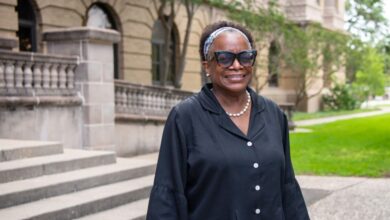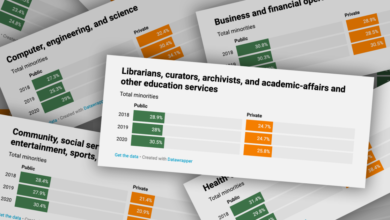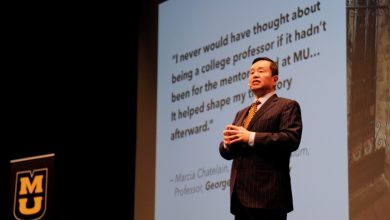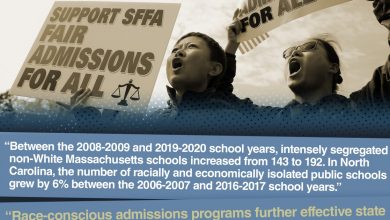College Presidents Created a Money Monster. Now Will They Tame It?

The signs are legion. The Supreme Court ruled 9-0 last summer that the National Collegiate Athletic Association, with its decades-old ban on player compensation, could not limit educational payments to athletes. State lawmakers nationwide defied the NCAA by passing laws that allowed athletes to make money from their names, images, and likenesses. And the National Labor Relations Board’s top lawyer recently declared what much of society has come to internalize: College athletes who bring in the most revenue for their institutions are employees and should be treated as such.
The NCAA’s supremacy is coming undone, and the resulting impact on higher education could be profound, says Eric J. Barron, president of Pennsylvania State University. He and others warn that as the association’s authority recedes, a corporate structure may emerge to control college football or that Congress could enact sweeping legislation to oversee all college athletics.
While those developments may not be welcome, many are ready to see the NCAA take a back seat. The association has been “remarkably ineffective” at dealing with the current challenges, Barron says, and has lost some of its credibility among college presidents.
Therein lies the irony. College presidents, shaking their heads at the association’s missteps, are also nominally in charge of it; they occupy a large majority of seats on the NCAA’s Board of Governors. The question now is whether presidents, particularly those at the 65 institutions at the pinnacle of college sports, will step up as individuals or as a group to make changes that benefit athletes, bring accountability to their programs, and fill the power vacuum left by the receding role of the NCAA.
Reining in the forces of commercialization for the association’s members is not something that presidents have exactly championed, given their responsibility for the prosperity of their own institutions. A losing football team can mean a drop in alumni donations, sales of university-branded swag, and possibly undergraduate applications.
“One of the problems is that those in decision-making positions have punted on the hard choices,” says Amy Privette Perko, CEO of the Knight Commission on Intercollegiate Athletics, an independent group that focuses on reforming college sports.
And punting may no longer be an option.
More often, a small group of university leaders have led the effort to cash in on the commercial success of college sports. In 1981, the University of Oklahoma and the University of Georgia sued the NCAA for the ability to negotiate the television rights for college football games.
Three years later, the Supreme Court ruled the association could no longer prevent individual colleges from negotiating with television companies to broadcast college-football games. The ruling opened the door to media-rights contracts — initially for universities and now for entire conferences — that have grown astronomically.
A little more than a year ago, the 14 universities that make up the Southeastern Conference signed a 10-year, $3-billion contract with the cable sports channel ESPN. The contract, which takes effect in 2024, is worth more than five times the annual value of the conference’s previous contract with CBS, according to news accounts.
Coaching salaries have followed suit. In 2021, three football coaches signed record-setting contracts, including Brian Kelly’s agreement with Louisiana State University — a member of the SEC — that are likely to top $100 million each over 10 years. The salary for a head coach in the NFL, by comparison, is about $8 million to $10 million annually, according to ESPN. Even assistant coaches at the premier college-football programs now routinely earn seven figures annually.
Presidents who oversee the most-successful athletics programs have also changed the association’s governance in a way that limits restraints on their commercial efforts.
In 1996, the association voted to change its governance structure to give each of its three divisions more control over the rules and policies specific to them, and place presidents at the top of each division’s separate board of directors. The change was made to accommodate Division I members (which include the largest and most-successful programs), that felt their interests were not best-served by including the lower Divisions II and III in making decisions, according to the authors Daniel Covell and Sharianne Walker in their book Managing Intercollegiate Athletics.

Mark Harris for The Chronicle; photos from Getty and iStock
The New York Times editorial board cheered the implementation of presidential control as a win for reformers. But others observed that money, not academic responsibility, had won the day. One unhappy athletics administrator said at the time that the “basic premise” of the restructuring was “that those who have invested the most money in our organization now make all the decisions.”
A quarter century later, the power and money in college sports have continued to coalesce around the colleges in a part of Division I now called the Football Bowl Subdivision, and especially 65 colleges in just five athletic conferences, dubbed the Power 5.
Instead of creating a national championship run by the NCAA, for example, the FBS colleges now participate in the the College Football Playoff, the subdivision’s semifinal and championship games, which are owned and operated by a separate corporate entity. That event generates some $500 million for the FBS. But that money is not shared among all NCAA divisions, as happens with the association’s March Madness basketball championship. Instead, nearly 80 percent of that amount goes to members of the Power 5, according to an analysis by the Knight Commission on Intercollegiate Athletics.
One common thread emerges from 25 years of presidential control: runaway revenue for the most prosperous institutions. That shouldn’t be a surprise, says Walker, dean of the College of Business at Western New England University and an expert in athletics governance.
“Presidents are paid to look out for their own institutions,” she says.
The public is losing its patience with the concept. In a concurring opinion attached to the educational-payments case, Justice Brett Kavanaugh gave voice to the idea, growing in prominence, that colleges’ argument in favor of amateurism as the defining feature of college sports is circular and self-serving. “Nowhere else in America can businesses get away with agreeing not to pay their workers a fair market rate on the theory that their product is defined by not paying their workers a fair market rate,” Kavanaugh wrote.
In response to the Supreme Court’s ruling and the wider backlash against amateurism, the NCAA voted in January for a new and much more streamlined constitution, giving the separate divisions and conferences an even bigger role in setting and enforcing their own rules and procedures. Presidents said that autonomy gave them the ability to set rules and policies more quickly, though they and the association have been vague about what that really means.
The NCAA’s new constitution does allow colleges to reward athletes with extra academic benefits, while also insisting that students shouldn’t be paid for playing a sport. That’s a start, say critics of the association, but still just a small step.
Julie Sommer, a lawyer and member of the Drake Group, which advocates for reform in athletics, says the changes are largely meant to shield the association from legal liability, in theory, by giving authority to the divisions and conferences, not the national association. But the changes don’t address more-fundamental problems in college sports by, for example, requiring colleges to provide adequate health insurance to athletes or ensuring they get a good education.
The new constitution also requires colleges and conferences to establish policies on athletes’ receiving compensation for use of their name, image, or likeness. That is a result of new laws in several states that allowed college athletes to have professional agents and get paid for work such as endorsing products on social media, signing autographs, or starting a new company or even a nonprofit organization.
While the NCAA must now allow such arrangements, the association’s delay in formulating rules has resulted in a confusing patchwork of state laws with little oversight or understanding of how to prevent misdeeds.
Welch Suggs, associate professor of journalism at the University of Georgia, says the new governance could lead to reduced accountability for bad actors, such as colleges that use endorsement deals as a form of inducement or companies that take advantage of athletes. “If nobody is paying attention to ethics and integrity in the Wild West” of name, image, and likeness deals, he says, “then who is going to hold anyone accountable?”
At its best, college athletics is “a wonderful cultural enterprise,” says Vincent Price, the president of Duke University. “The problem is if we devolve into just a business proposition.”
Susan Wente, president of Wake Forest University, emphasizes that the vast majority of college athletes will not have an opportunity to play professionally, and that many receive the benefit of attending a top-ranked university on a generous scholarship.
“We want what’s best for our students,” Wente says, “to pursue their passions while getting a great education.”
But the goal of treating big-time college athletes just like other students on campus frequently conflicts with the outsized pressures to compete on the field and financially. Leading athletics programs across the country have created a steady stream of controversy in recent years for failing to deal with sexual misconduct, improper financial arrangements between coaches and outside companies, and widespread academic fraud.
At the same time, governing boards and alumni boosters expect winning teams; presidents who dare cross them, even for the sake of the institution’s values and integrity, may find themselves out of a job.
That dynamic has forced any number of university presidents into a moral dilemma: look the other way in the face of wrongdoing or be forced out after seeking accountability. A recent example is the case of F. King Alexander, who resigned under pressure as president at Oregon State University after an investigative report found he had failed to fire the football coach for sexual misconduct at Louisiana State University. In Baton Rouge, Alexander said, there was “a great deal of board intervention into athletics.”
With the possibility of name, image, and likeness deals and extra academic benefits, football and men’s basketball coaches may be tempted to use money as an inducement to recruit players.
Wealthy alumni, too, may get involved in trying to attract students with the promise of a payoff. Some of the arrangements used by colleges to help athletes with name, image, and likeness deals have already raised questions. At the University of Oregon, alumni, including Phil Knight, the co-founder of Nike, have formed a company to help athletes market themselves. The NCAA is looking into that situation, according to a news account from Sportico.

Mark Harris for The Chronicle
Price says his concerns about money are not the dollars coming into the institution from athletics, but the growing number of companies outside the university that may seek profit at the expense of the athlete.
“We are nonprofit institutions that must expend that money to meet our values,” Price says. “The problem is people who simply want to extract dollars and don’t have an institutional interest.”
But presidents may have long ago abdicated their role as responsible stewards of institutional integrity. Holden Thorp, who stepped down as chancellor of the University of North Carolina at Chapel Hill in the wake of a scandal involving fake courses for more than a thousand athletes, said cheating and misbehavior are rampant at big-time programs. If presidents don’t see it, they aren’t really looking.
New governance and rules that give presidents more authority to shape college sports won’t protect them from boards determined to micromanage, Thorp says. Instead, “they will give even more power to the jock-sniffing trustees and alumni.”
In a federal class-action lawsuit in Pennsylvania, college athletes are mounting their latest challenge to the NCAA’s ban on paying players. In this case, a group of players argue that they should be considered employees under federal and state laws, and eligible for minimum wage and overtime pay. In July, the judge in the case asked the parties to submit memos responding to the Supreme Court’s June decision that found the NCAA could not prohibit payment for extra academic benefits.
The movement to unionize college athletes also got a boost last year. In September, the general counsel of the National Labor Relations Board, Jennifer Abruzzo, issued a memo outlining her opinion that some college players would qualify as employees under federal law. The effect of that guidance is that athletes at some private colleges could eventually form a union and bargain for employee rights, including for pay and working conditions.
Abruzzo said the Supreme Court’s decision set the stage for her guidance: that athletes meet the federal labor law’s definition of an employee by performing “services for institutions in return for compensation and subject to their control.”
Some athletics administrators now see this as an inevitability. Bubba Cunningham, athletics director at the University of North Carolina at Chapel Hill, said in an interview with AthleticDirectorU that the NLRB opinion and recent court rulings will probably force a change in the relationship between the university and its athletes. “There might be an employee-employer relationship between the student and the university, and I think within the next two or three years we’ll have to sort through that,” Cunningham said.
“If we just think we’re going to continue on five years from now like it looked five years ago,” Cunningham said, “that’s just not the case.”
Members of Congress, too, have taken an interest in college athletics, filing more than a half-dozen bills, so far, to deal with athlete compensation, health, educational outcomes, and more, though even advocates for federal legislation acknowledge it’s unlikely college-sports legislation survives the current gridlock on Capitol Hill.
The scope of reform is just too big for institutions to handle on their own, says Jennifer Hoffman, an associate professor at the University of Washington who teaches in the Center for Leadership in Athletics. “If we want real reform, we are going to have to do something different, the only example I can think of is at the federal level,” Hoffman says.
A more far-reaching proposal, by some reform advocates, would separate college football in the Power 5 from the rest of the athletics department. College football is already “worlds apart” from other sports in terms of the money it generates and the way it is operated, says Victoria Jackson, a sports historian at Arizona State University and former NCAA athlete.
A major hurdle to all of these approaches is the business model of college sports, where the revenues from football and men’s basketball cover the expenses of all the other sports. Paying athletes as employees could lead the government to tax football revenues as unrelated business income, stripping the money that is used to pay for other sports.
Rocky Harris, CEO of USA Triathlon, says that the loss of support for Olympic sports is a concern if college football follows a professional model. But the amount of money programs are spending on top-tier coaches and facilities under the current model is also a real problem for Olympic sports.
“If you surveyed athletes, they’d rather have the money and less-glamorous facilities,” says Harris, who was previously chief operations officer at Arizona State University. “The system is out of whack,” he says, and leaders are “making the same mistakes now that they were making 10 years ago.”
While presidents have been seen as dragging their feet on athletic reforms, they may also fear any national approach that could curtail their competitiveness and, more importantly, their profits.
“Institutions want autonomy in dealing with their finances,” says the Knight Commission’s Perko, “so there is going to be resistance to any rules or framework that would address how they use their revenues.”
Jackson is not hopeful that presidents will, after decades of debate, now step up to find that balance.
“They’re purposefully choosing not to figure it out,” she says. “It’s a great disappointment that college presidents haven’t taken over this issue; that should have started a long time ago.”
Source link







